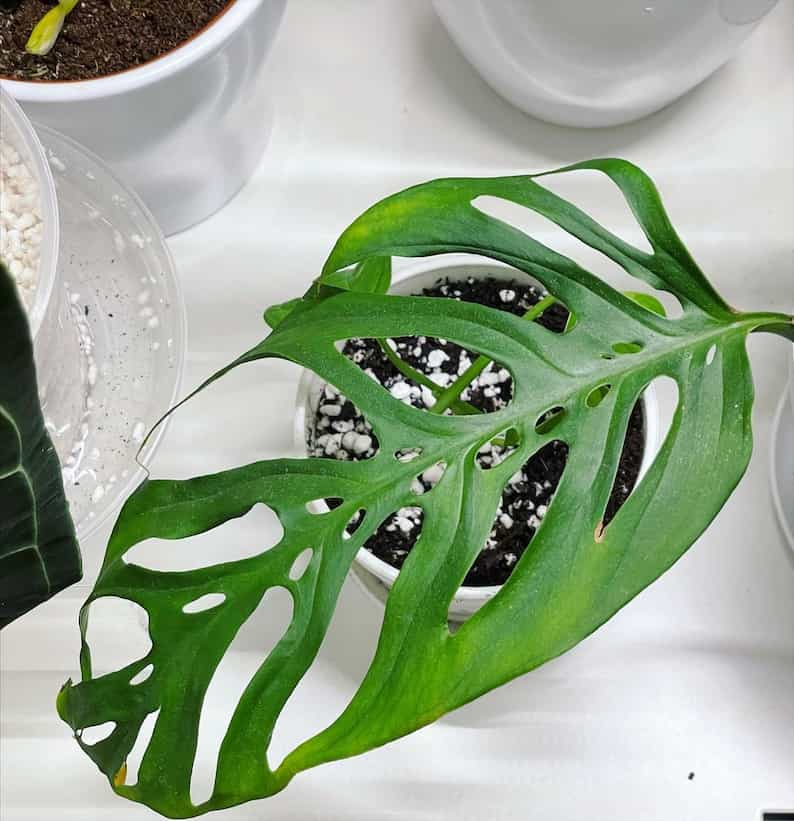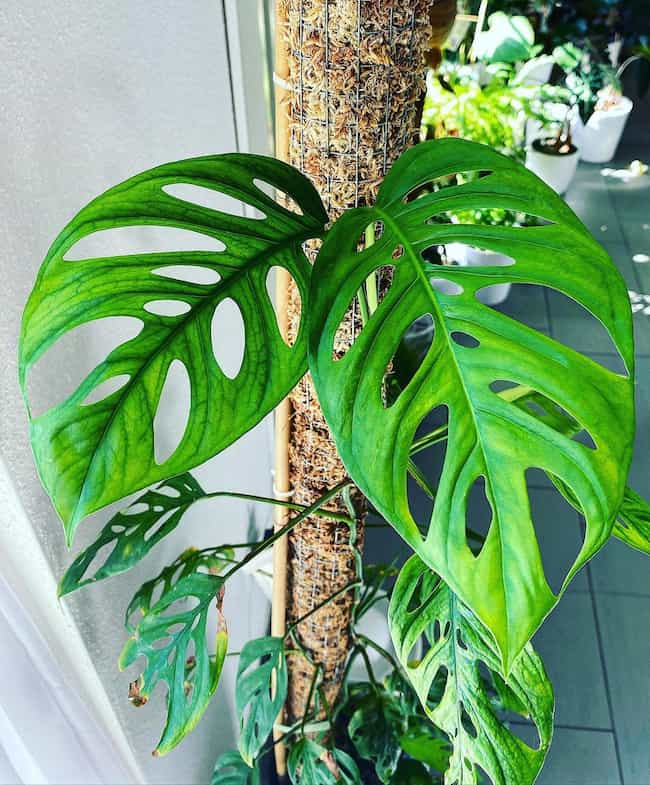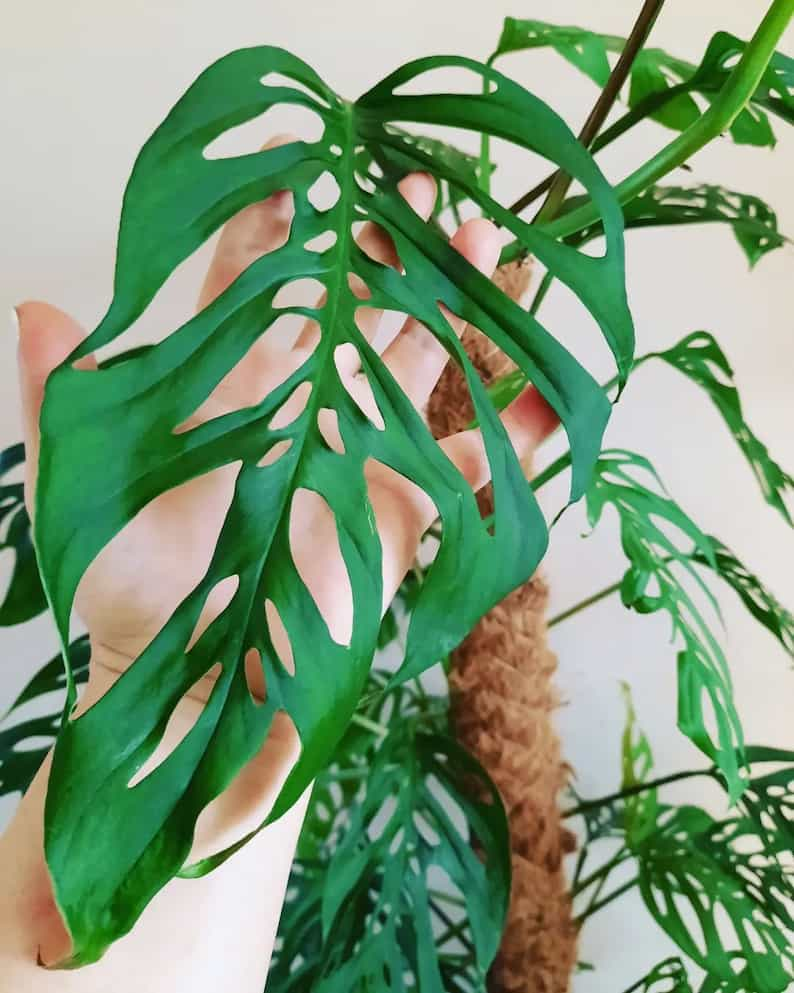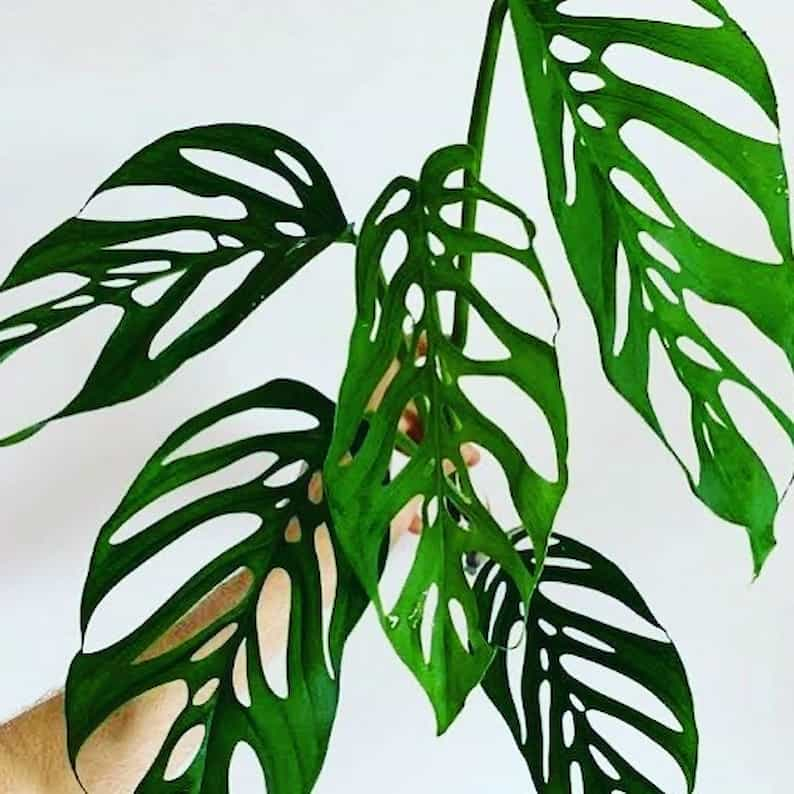Enigmatic, uncommon, and beautiful, the Monstera Laniata is a wonderful addition to any Monstera collection, made doubly rewarding by how easy it is to care for. Technically speaking, the Laniata is a subspecies of Monstera adansonii, but this gorgeous plant is a thrilling specimen in its own right, with some very unique distinguishing features.
Indeed, while it can be challenging to tell a Laniata from a regular adansonii, the giveaway lies in its leaves. The Laniata possesses foliage of a deeper, more brilliant green, with a glossy underside instead of the matte texture of the adansonii. The Laniata’s leaves are also bigger and have more uniform fenestrations, particularly as it matures.
In this post, we’ll look at what it takes to care for Monstera Laniata, how to propagate them, and how to tell them apart from their Monstera cousins that are similar in appearance. If you’re considering adding one of these marvels to your collection, I can guarantee you won’t regret it.
Table of Contents
How do you care for a Monstera Laniata?
Caring for a Monstera Laniata is straightforward as these plants require very little maintenance. They enjoy medium to bright light, regular access to water, occasional fertilization, high humidity, and good-quality, well-draining potting soil. A climbing pole and occasional pruning are advisable.
Like the adansonii, the Monstera Laniata is an easy plant to look after and will reward you greatly if you meet its basic needs. It doesn’t ask for much in terms of upkeep, and if your fundamentals are correct with regard to positioning, soil, hydration, and humidity, you should have no problem getting your Laniata to thrive.

In addition to its primary care, it’s also a good idea to provide your Laniata with a climbing pole or totem. These beauties are endemic to the jungle regions of South America, where they live in the dappled light of larger trees and plants and climb upwards towards the forest canopy.
In a home environment, they are happiest when they have something to attach their aerial roots to and so, like other members of this plant family, giving a moss pole for your Monstera Laniata can do wonders towards helping to care for your new houseplant.
Once established, you may also find that it’s necessary to prune your Laniata from time to time. As its leaves age, they may start to degrade or perish, which is irreversible and ultimately a waste of your plant’s energy. Chopping away dead growth keeps your Laniata looking bright and healthy and makes way for new development.
Let’s look at each Monstera Laniata care step in greater detail.
Monstera Laniata light needs
Monstera Laniata enjoy medium to bright indirect sunlight. Even though these plants originate in the jungle, their delicate leaves cannot handle the sun’s scorching rays and can end up burning or wilting. For this reason, Laniata are best placed near East- or North-facing windows that filter through morning sun.
To keep your Laniata in tip-top shape by meeting your Monstera’s light requirements, rotate it every few days so that all its leaves receive equal sun. If your Laniata shows any signs of drooping or drying out, move it into a more shaded area and reduce its daily light intake. Outdoors, Monstera should be grown in the shelter of larger plants or shading structures.
All that being said, don’t fret if you don’t have a bright sunny window or garden. These beauties do okay in dimmer light conditions too. They may be a little more scraggly than usual, but they are still able to grow, depending more on humidity and warmth than light itself. In fact, bathrooms are some of the best places to keep Laniata, as moist environments closely emulate their jungle origins.
How often should you water Monstera Laniata?
Monstera Laniata love a bit of dampness, but they hate being drenched. Striking a balance between overwatering and underwatering can be challenging, so it’s best to do frequent checks of their soil to ensure it’s neither too dry nor too wet. Generally, a moderately-sized Laniata will need water every 7 to 9 days.
This does, however, depend on a few factors. Firstly, in the warmer months, they’ll consume more water than in the winter, at which time you may need to extend periods between waterings to once every 8 to 10 days. Secondly, the moisture retention of your soil comes into play.

Depending on its composition, some soil mixes retain water better than others. To be safe, you can check your soil with a fingertip every 3 to 4 days. If it’s dry down to your first knuckle, it’s time for watering. More than 40% dried out is the danger zone.
Overwatering and underwatering can both be problematic for Laniata, so getting this right is a must. While they can be rescued from water damage, it can irreparably harm some of their hard-earned foliage, so it’s best to prevent this where possible. At worst, severe overwatering a Monstera can cause root rot, which is tricky to overcome. Worried? Invest in a moisture meter to set your mind at ease.
Related: Exactly How Often to Water Your Monstera
What temperature is best for Monstera Laniata?
Monstera Laniata aren’t super fussy when it comes to temperature, although they do (like most Monstera) prefer warm weather. Anywhere in the range of 60F to 80F (16C to 26C) should be okay, but lower than that, and they may suffer from stunted growth or complete dormancy.
Indoors, Laniata aren’t partial to drafts or air conditioners, and outdoors they will suffer if exposed to harsh winds, frost, or snow, so make sure they remain somewhere that aligns with the temperature that Monstera like.
How much humidity does Monstera Laniata need?
Laniata thrive in high humidity, optimally around 80% to 90%. However, they still grow well in humidity levels as low as 50% to 60%. Of course, we all want what’s best for our plants, so to really pump up your Monstera’s living conditions, consider adding some extra moisture to their environment.
Pebble trays are wonderful for this, as they’re low cost and don’t need much maintenance. Damp pebbles set under your Laniata will evaporate water over time, providing your plant with a kick of humidity. Similarly, a plug-in humidifier can add moisture to a room while freshening the air and keeping your plants happy. For added measure, misting your Laniata’s leaves once a week will moisturize them and leave them looking healthier.
As a side note, if you have an extensive collection of plants, clustering them together creates a mutually beneficial environment, as they give off humidity to one another. If your Laniata is struggling, try moving it into a kitchen or bathroom space, as the air in these rooms tends to be damper.
Find out more: 12 Proven Tips to Get Your Monstera the Humidity It Needs
What kind of soil does a Monstera Laniata need?
An optimal soil mix for a Monstera Laniata is nutrient-rich, well-draining, and airy. Preblended Monstera mixes work well, but you can mix your own soil by combining certain key ingredients. A good soil blend will have a chunky substrate like orchid bark or moss for aeration and nutrients, a moisture-retaining substance like perlite, and a pH balancer like activated charcoal.

The type of soil that a Laniata needs correlates to its relationship to water. Monstera thrive on moisture but not on soggy ground, and the perfect solution for this is a substance that retains hydration without weighing down your Laniata’s roots. Perlite and moss, for example, hold in H20 while simultaneously encouraging airflow. They also provide much-needed nutrients to your Monstera.
In terms of soil acidity, for perfect Monstera Laniata care, they prefer a neutral to slightly acidic pH level, which is bolstered by the addition of charcoal to your soil. This works hand in hand with quality potting soil, which is usually relatively neutral to begin with. Once all your ingredients are mixed together, you should have a healthy home for your plant.
Related: What’s the Absolute Best Soil for Monstera Plants?
Does Monstera Laniata need fertilizer?
Monstera Laniata are vigorous growers and therefore use quite a lot of energy from the sun, water, and nutrients embedded in their soil. Extra food in the form of fertilizer benefits them in this regard, giving them a much-needed boost to grow to their full potential.
A good feeding regime for a Laniata is a monthly dose of slow-release, balanced organic fertilizer once a month during spring and summer. As this plant enters dormancy in fall and winter, it will not expend as much energy and doesn’t require feeding.
Related: How to Fertilize Your Monstera So Your Plant Thrives
Do I need to repot my Monstera Laniata?
As important as light, water, humidity, and soil is making sure your Monstera Laniata has a secure planter with appropriate drainage. Ideally, your plant baby is going to live in its planter for at least two years before it needs to be transplanted, so make sure you choose a good home for it from the get-go.
Of course, if you’re buying your Laniata from a nursery or garden center, it may already be potted. However, in the event that you are growing your Monster from a cutting or plastic shipping planter, you will need to select its pot yourself.
This is quite simple to do. That is, when it comes to the best pot for your Monstera, make sure you choose one twice as wide and twice as deep as your plant’s roots (when its root ball is spread). Most importantly, make sure it has plenty of drainage holes so that excess water doesn’t pool in your soil.
Monstera Laniata only need to be transplanted once they outgrow their space or become rootbound.
Related: When to Repot a Monstera to Keep Your Plant Happy
Does a Monstera Laniata need a climbing pole?
While a Monstera Laniata doesn’t strictly need a climbing pole, it is advisable to keep their growth as aesthetic as possible. As epiphytes, Laniata have aerial roots, and their natural instinct is to attach to support structures, like trees, in the wild. Totems like moss or coco coir poles also provide additional nutrients to your plant.
To help your Monstera Laniata climb, you can start them off by gently attaching their stems to your chosen structure with florist’s tape or clips. Their roots should take by themselves in a few weeks, and then you can remove your adhesives.
You can train Monstera Laniata to climb in specific directions, but the chances are high that with regular rotation toward the light, they’ll end up growing upwards most pleasingly all by themselves.

Should I prune my Monstera Laniata?
Pruning is good practice for keeping your Laniata as healthy and good-looking as possible. Aim to do this in the spring and summer, which are Monstera’s most productive growing months and so are the perfect time to give them a trim and remove any dead or decaying leaves. This helps to refocus your plant’s energy on new growth.
You can see a full guide on how to prune a Monstera in our article to help you do this perfectly the first time.
How do I know if my Monstera Laniata has root rot?
Plants in the Monstera genus are considered hardy, but they can be very susceptible to root rot. Any sign of yellowing leaves, drooping, wilting, or a generally lackluster appearance may indicate that a fungal or bacterial infection has occurred in your soil. Unfortunately, this usually results from overwatering.
To diagnose root rot in a Monstera, feel your plant’s soil. If it’s soggy and smells a little off, it may be that a fungus has started to set in. If this is the case, hold off on watering your plant for a while so it can dry out and place it in a bright warm place.
If the infection is far gone, you will need to transplant your Monstera into fresh soil and prune away mushy damaged roots.
Is Monstera Laniata rare?
Monstera Laniata is not rare, but it is uncommon. Further complicating this is the fact that this particular subspecies is often misclassified as a standard adansonii and vice versa. Either way, Laniata are now readily obtainable via specialist plant suppliers or private online sellers.
Before the current houseplant craze kicked in, plenty of Monstera were a lot more uncommon and harder to find. Luckily for collectors, social media and the like has cast the spotlight on so many beautiful and unique varieties, like the Laniata, which has, in turn, made them accessible.
This is not to say that you’ll stumble on a subspecies like the Laniata in your local garden center, as they still remain among the lesser known Monstera varieties. But, you can probably find one in or close to your vicinity with a bit of digging, or if you’re really fortunate, beg a cutting from a fellow collector.

What is a Monstera Laniata?
Monstera Laniata, also known as Monstera adansonii variety Laniata, is a subspecies of fenestrated Monstera in the Araceae family. It has glossy, dark green leaves and large apertures that run in strips down its center vein. It can grow up to 12 feet tall (3.65 meters).
While classified as a subspecies of the Monstera adansonii, the Laniata is a true beauty in its own right. With its big green leaves and easy-going nature, it’s becoming more and more popular and easy to recognize.
Indeed, there are apparent differences between the adansonii and the Laniata variety, particularly once they reach maturity. The Laniata is much bigger, for instance. And where the adansonii has fenestrations seemingly springing up at random (giving it a Swiss Cheese look), the Laniata’s apertures are more uniform and closer to the leaf’s central rib.
How do you propagate Laniata?
Laniata should be propagated from stem cuttings for your best chance of success. You can either place them straight into a prepared soil container or root them first in water. In both cases, you will need a cutting with at least two viable nodes and one to three leaves.
Monstera Laniata propagation is easy and rewarding. All you need is a good stem cutting and some patience, and in four to six weeks, you’ll have a juvenile ready for transplanting. In what follows, we’ll look at how to propagate a Monstera Laniata straight into soil or, alternatively, how to root one in water. But first, let’s look at identifying a healthy and promising stem.
When taking a cutting, you want to look for healthy nodes, as this is the spot where your cutting develops its roots. Two to three nodes are best, but a cutting can also successfully propagate from one node if that’s all you have to work with. Your stem should also possess one or two leaves to draw in sunlight energy.
Once you have your stem in hand, you’re ready to make the snip. Ensure your tools are clean and that your planter or water jar is prepared, so your cutting’s end isn’t exposed to too much air.
Propagating a Monstera Laniata cutting in soil
To propagate a Monstera Laniata cutting in soil, start by preparing your planter with a good-quality, well-draining soil mix. In an earlier section of this article, we covered the ideal earth blend for Monstera, which you can use as a guideline for propagation soil too.
Once you have your planter ready, all you need to do is pop your cutting into the soil, moisten it, and provide it with plenty of humidity. For this, I recommend either covering your cutting with a plastic dome or a plastic bag, which locks in moisture and keeps the air around your new plant damp.
This is because a plant without roots cannot draw water from the earth until it develops new growth. Until then, it relies on moisture drawn directly into its tissue via its stem or leaves. In good news, it should only take a few weeks for your plant to settle and root, after which you can care for it just as you would any other Laniata.

Propagating a Monstera Laniata cutting in water
Rooting stem cuttings in water is my go-to for propagating Monstera, as I love to watch them develop new roots, and to be honest, I believe this is the surest way to success. Best of all, it’s effortless.
All you need to do in order to grow your Monstera in water is prepare a well-sized glass container with fresh water and pop your cutting into it, ensuring the nodes are covered. Place the jar in a sunny spot and refresh the water weekly.
In four to six weeks, you should see new roots. Once they are one to two inches long (2 to 5 centimeters), you can transplant your Laniata baby into a planter with soil and watch it flourish and mature.
Is Monstera Laniata the same as adansonii?
The Monstera Laniata is a subspecies of adansonii. They are both fenestrated Monstera native to Central and South America. They look very similar as juvenile plants, but as they mature, they develop some notable differences in appearance.
The best way to describe the Laniata and adansonii is similar but different. These two beautiful plants are closely related and share many similar traits. However, it must be noted that the Laniata is a subspecies and thus not entirely the same.
Monstera adansonii vs Monstera Laniata difference
The main difference between the Monstera adansonii and Monstera Laniata is the fenestration on their leaves. The Laniata is bigger and has almost symmetrical fenestrations on its leaves that are narrow and lengthy, running down its center veins. The underside of the Laniata’s leaves are also a darker, glossier green than those of the adansonii.
That is, while the Laniata is a subspecies of adansonii, its fenestration pattern and size are quite different from the standard adansonii.
Monstera adansonii is a weird and wonderful Monstera, also referred to as the Swiss Cheese plant or Monkey Mask, due to its widespread, sporadic fenestrations. The similarities between the two are clear, but they’re not identical, especially when you look at their leaves closely.
Find out everything you need to know about how to care for a Monstera adansonii here.
Monstera Laniata vs Acuminata
The main differences between the Monstera adansonii Laniata and the Monstera Acuminata are in the color of their leaves and the size of their fenestrations. The Laniata is lighter, with bigger leaves and many large apertures, whereas the Acuminata is darker and smaller.
It’s easy to confuse these two beautiful plants, but the secret is in their holeyness. Monstera Acuminata have smaller fenestrations than Laniata, which has bigger holes more akin to something like the Monstera Lechleriana – although the Acuminata has more of them per leaf. They are also less ordered and further from the center rib. Additionally, the Acuminata has smaller, darker leaves overall.
Monstera Laniata vs Esqueleto
The main difference between the Monstera Laniata and Esqueleto is in their leaves, as the Esqueleto is substantially more fenestrated than even the Laniata, although not quite to the degree of the Obliqua. The Laniata’s fenestrations are also closer to the middle of each leaf, running along the center stem.
Furthermore, the Monstera Esqueleto (also often referred to by its other name, Monstera Epipremnoides) has leathery leaves, in contrast to the larger, lighter green leaves of the Laniata.
The Laniata and Esqueleto are both beautiful and strange, but they are generally easy to tell apart thanks to the Esqueleto’s signature lacy fenestrations, which make up roughly 80% of their surface area, similar to what you see with the Monstera obliqua. While the Laniata also has substantial splits in its leaves, the fact that these will be aligned along the center of the leaf can be an easy giveaway on which type of Monstera you’re dealing with here.
